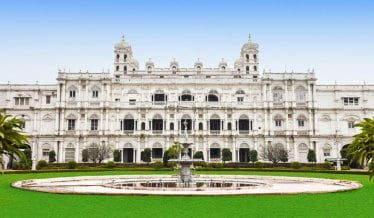Nestled in the heart of Gwalior, Madhya Pradesh, the Jai Vilas Palace stands as a breathtaking testament to the opulence and grandeur of Indian heritage. Renowned for its magnificent European-inspired architecture, this majestic edifice serves not only as a symbol of regal splendor but also as a living testament to the illustrious legacy of the House of Scindia, a revered Hindu Maratha dynasty that once wielded unparalleled influence over the historic city of Gwalior. With an estimated value surpassing Rs 4,000 crore, the Jai Vilas Palace epitomizes extravagance on an unparalleled scale, spanning an awe-inspiring 12,40,771 square feet.
Today, this resplendent palace stands as the cherished abode of the Scindia family, preserving centuries of history within its hallowed halls and enchanting courtyards. As a beacon of cultural heritage and architectural brilliance, the Jai Vilas Palace continues to captivate visitors from around the globe, offering a glimpse into the grandeur and magnificence of India’s royal past.
European Influence
The palace is a three-storey building that pays homage to Tuscan, Italian, and Corinthian architectural styles. The first floor features Tuscan design, the second floor is Italian-Doric, and the third floor is inspired by Corinthian and Palladian styles.
The Durbar Hall
One of the most stunning features of the palace is the Durbar Hall, which is adorned with 560 kg of gold. This hall, used for royal meetings, showcases Neoclassical and Baroque influences. To test the strength of its roof, eight elephants were suspended from the ceiling before installing two massive chandeliers, each 12.5 meters high, weighing 3500 kg, and fitted with 250 bulbs.
Silver Model Train
A distinctive feature of Jai Vilas Palace is the model train made of solid silver, located on the dining table. This train was used to serve brandy and cigars to guests, adding a unique touch of luxury to the dining experience.
Historic Museum
The palace houses 400 rooms, of which 35 have been converted into a museum. This museum displays a collection of artefacts from the Maratha Scindia Dynasty, including a silver chariot, palanquins, a silver buggy, and vintage luxury cars.
Among the notable exhibits are the original shield of Jhansi Ki Rani and swords from the reigns of Aurangzeb and Shah Jahan.
Historical Significance
The Jai Vilas Palace was built in the 19th century to welcome Prince George and Princess Mary of Wales during their visit to India in 1876. The foundation was laid in 1874 under Maharaja Jayaji Rao Scindia’s patronage and designed by British Lieutenant-Colonel Sir Michael Filose. Today, the palace is inherited by Jyotiraditya Madhavrao Scindia, the grandson of Jivajirao Scindia, as per a DNA report.
Current Valuation
Originally valued at Rs 1 crore during its construction, the palace’s worth has skyrocketed to over Rs 4,000 crore today, reflecting its historical and cultural significance, according to various media reports.
